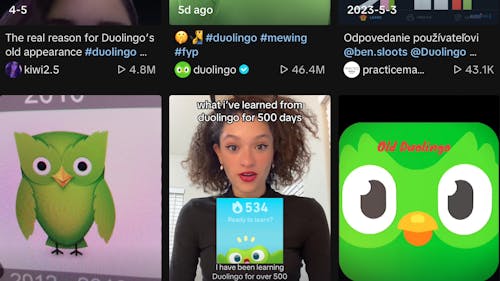Misery loves company: Why brands like Duolingo need advertising overhauls

Recently, Duolingo users have noticed a drastic change in their beloved app. Instead of the smiling green bird, known to continually pester users for missing daily lessons, they've been greeted with a weird, sad version of the owl.
Duolingo hasn't been entirely upfront about why this icon change happened — a spokesperson for the company joked that the owl is just tired after the company's recent advertising schemes. But it's not too hard to guess why the company is actually doing this.
Making weird changes like this gets people talking about the app — ultimately, it's been a pretty successful marketing tactic for the brand.
This isn't the first time Duolingo has gone viral for its unique choices. It's become a popular meme that the Duolingo owl can be quite intense about reminding people to do their daily language learning practice.
The company has leaned right into this meme, creating content like this TikTok video that has a sarcastically threatening tone to it. So, the app's icon change, while initially jarring, isn't the strangest thing Duolingo has done.
Duolingo is certainly not the first company to adopt an eccentric persona on social media as a means of getting people to pay attention. Wendy's is perhaps the most well-known example — it's been known for having a humorous presence on social media platform X since 2017, where it playfully roasts users.
Recently, more companies have begun to adopt this strategy. Denny's has taken this approach to Instagram, creating brand-related parodies of big pop culture moments. For the release of Beyoncé's "Cowboy Carter" album, the brand uploaded a meme of a photoshopped stack of pancakes onto the album cover.
So, why has this become so popular in recent years?
It's likely an attempt at making brands feel more "human," as it's been shown that consumers prefer brands that they can connect to. But, while making humorous marketing choices and interacting with social media users can be fun and light-hearted, it doesn't get to the core of what consumers want — the brand's values.
Before buying a product, socially conscious customers will want to know how it's made and how the parent company treats its employees.
Sure, users might get a laugh or two out of a silly Instagram post or funny icon change, but these things don't say much. If companies want to connect with their consumers, being upfront about the causes they care about is a more effective way of doing so. Ben and Jerry's is a prime example of this.
Ben and Jerry's consistently posts about its political stances and support for social justice on its Instagram page. Of course, this tactic is not without fault — while it will potentially gain the support of consumers with similar viewpoints, it runs the risk of alienating customers who disagree with a company's opinions.
A less divisive approach would be along the lines of what Wendy's has recently done. Instead of relying on memes and jokes, the company has been vocal about its partnership with the Dave Thomas Foundation for Adoption. This way, it can connect with consumers through both funny social media interactions and social changes.
If you were perplexed by the new Duolingo icon, remember it's just a marketing tactic to get you talking, albeit not the best one to keep users engaged and connected with the app. Instead of relying on attracting short-term media attention, brands need to consider using their platforms to spark real change.



